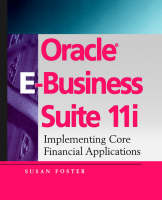Oracle e-Business Suite 11i
Oracle e-Business Suite 11i
Implementing Core Financial Applications
Foster, Susan
John Wiley & Sons Inc
11/2001
360
Mole
Inglês
9780471412052
0471412058
632
HARNESS THE FULL POWER OF ORACLE'S POWERFUL NEW UPGRADE Oracle is the second largest software company in the world, second only to SAP in ERP vendors. Now, after five years, Oracle has come out with the newest release of their ERP system, version 11i.
Introduction. Oracle Application Methodology. Hardware. Software. Data. People. Procedures. Project Methodology. Chapter 1. Concepts. Overview. Oracle E-Business Suite 11i Integration. Oracle Glossary. Chapter 2. Oracle Applications Navigation. Overview. Accessing Oracle Applications. Select Responsibility. Navigate. Data Entry Mode. Query Mode. Chapter 3. Setting Up Oracle Applications. Overview. System Administrator Step 1.1: Responsibility. System Administrator Step 1.2: User. System Administrator Step 1.3: Printer. System Administrator Step 1.4: Profile Values. System Administrator Step 1.5: Concurrent Processes. Chapter 4. Flexfields. Overview. Accounting Flexfield. Descriptive Flexfields. Accounting Flexfields Step 2.1: Setup. Accounting Flexfields Step 2.2: Values. Accounting Flexfields Step 2.3: Cross-Validation Rules. Chapter 5. General Ledger. Overview. Using General Ledger. Setup. General Ledger Step 3.1: Calendar. General Ledger Step 3.2: Set of Books. General Ledger Step 3.3: Profile Values. General Ledger Step 3.4: Intercompany Account. General Ledger Step 3.5: Open Period. Journals. Budgets. Inquiry and Reporting. Period-End Process. Chapter 6. Multi-Org. Overview. Setup. Multi-Org Step 4.1: Human Resources User Profile. Multi Org Step 4.2: Locations. Multi Org Step 4.3: Organizations. Multi Org Step 4.4: Responsibilities. Multi Org Step 4.5: Profile Values. Multi Org Step 4.6: Adamin. Multi Org Step 4.7: Other Profile Values. Chapter 7. Payables. Overview. Setup. Payables Step 5.1: Lookup Codes. Payables Step 5.2: Select Set of Books. Payables Step 5.3: Profile Values. Payables Step 5.4: Payment Terms. Payables Step 5.5: Financial Options. Payables Step 5.6: Expense Report Template. Payables Step 5.7: Bank Accounts. Payables Step 5.8: Payables Options. Payables Step 5.9: Reporting Entities. Payables Step 5.10: Open Period. Suppliers. Invoices. Credit Memos. Matching to Purchasing. Prepayments. Employee Expense Report. Recurring Invoice. Payments. Inquiry and Reporting. Period Process. Open/Close Period. Chapter 8. Receivables. Overview. Setup. Receivables Step 6.1: Flexfields. Receivables Step 6.2: System Options. Receivables Step 6.3: Payment Terms. Receivables Step 6.4: Open Period. Receivables Step 6.5: AutoAccounting. Receivables Step 6.6: Transaction Types: Credit Memos. Receivables Step 6.7: Transaction Source. Receivables Step 6.8: Collectors. Receivables Step 6.9: Approval Limits. Receivables Step 6.10: Receivable Activities. Receivables Step 6.11: Bank Accounts. Receivables Step 6.12: Receipt Classes and Payment Methods. Receivables Step 6.13: Receipt Sources. Receivables Step 6.14: Statement Cycles. Receivables Step 6.15: Profile Values. Receivables Step 6.16: Customer Profile Class. Receivables Step 6.17: Customers. Receivables Step 6.18: Remit-to Addresses. Receivables Step 6.19: (Standard) Memo Lines. Receivables Step 6.20: Tax Codes. Customers. Invoices. Credit Memos. Printing. Receipts. Inquiry and Reporting. Period Process. Index.
Este título pertence ao(s) assunto(s) indicados(s). Para ver outros títulos clique no assunto desejado.
HARNESS THE FULL POWER OF ORACLE'S POWERFUL NEW UPGRADE Oracle is the second largest software company in the world, second only to SAP in ERP vendors. Now, after five years, Oracle has come out with the newest release of their ERP system, version 11i.
Introduction. Oracle Application Methodology. Hardware. Software. Data. People. Procedures. Project Methodology. Chapter 1. Concepts. Overview. Oracle E-Business Suite 11i Integration. Oracle Glossary. Chapter 2. Oracle Applications Navigation. Overview. Accessing Oracle Applications. Select Responsibility. Navigate. Data Entry Mode. Query Mode. Chapter 3. Setting Up Oracle Applications. Overview. System Administrator Step 1.1: Responsibility. System Administrator Step 1.2: User. System Administrator Step 1.3: Printer. System Administrator Step 1.4: Profile Values. System Administrator Step 1.5: Concurrent Processes. Chapter 4. Flexfields. Overview. Accounting Flexfield. Descriptive Flexfields. Accounting Flexfields Step 2.1: Setup. Accounting Flexfields Step 2.2: Values. Accounting Flexfields Step 2.3: Cross-Validation Rules. Chapter 5. General Ledger. Overview. Using General Ledger. Setup. General Ledger Step 3.1: Calendar. General Ledger Step 3.2: Set of Books. General Ledger Step 3.3: Profile Values. General Ledger Step 3.4: Intercompany Account. General Ledger Step 3.5: Open Period. Journals. Budgets. Inquiry and Reporting. Period-End Process. Chapter 6. Multi-Org. Overview. Setup. Multi-Org Step 4.1: Human Resources User Profile. Multi Org Step 4.2: Locations. Multi Org Step 4.3: Organizations. Multi Org Step 4.4: Responsibilities. Multi Org Step 4.5: Profile Values. Multi Org Step 4.6: Adamin. Multi Org Step 4.7: Other Profile Values. Chapter 7. Payables. Overview. Setup. Payables Step 5.1: Lookup Codes. Payables Step 5.2: Select Set of Books. Payables Step 5.3: Profile Values. Payables Step 5.4: Payment Terms. Payables Step 5.5: Financial Options. Payables Step 5.6: Expense Report Template. Payables Step 5.7: Bank Accounts. Payables Step 5.8: Payables Options. Payables Step 5.9: Reporting Entities. Payables Step 5.10: Open Period. Suppliers. Invoices. Credit Memos. Matching to Purchasing. Prepayments. Employee Expense Report. Recurring Invoice. Payments. Inquiry and Reporting. Period Process. Open/Close Period. Chapter 8. Receivables. Overview. Setup. Receivables Step 6.1: Flexfields. Receivables Step 6.2: System Options. Receivables Step 6.3: Payment Terms. Receivables Step 6.4: Open Period. Receivables Step 6.5: AutoAccounting. Receivables Step 6.6: Transaction Types: Credit Memos. Receivables Step 6.7: Transaction Source. Receivables Step 6.8: Collectors. Receivables Step 6.9: Approval Limits. Receivables Step 6.10: Receivable Activities. Receivables Step 6.11: Bank Accounts. Receivables Step 6.12: Receipt Classes and Payment Methods. Receivables Step 6.13: Receipt Sources. Receivables Step 6.14: Statement Cycles. Receivables Step 6.15: Profile Values. Receivables Step 6.16: Customer Profile Class. Receivables Step 6.17: Customers. Receivables Step 6.18: Remit-to Addresses. Receivables Step 6.19: (Standard) Memo Lines. Receivables Step 6.20: Tax Codes. Customers. Invoices. Credit Memos. Printing. Receipts. Inquiry and Reporting. Period Process. Index.
Este título pertence ao(s) assunto(s) indicados(s). Para ver outros títulos clique no assunto desejado.





